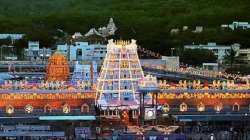TTD's claim on Hanuman's birthplace at Tirumala Hills creates stir in Karnataka
The Tirumala Tirupati Devasthanams claim that Tirumala Hills is the abode of Lord Hanuman and they would release an 'evidence' based book has created a stir in religious and archaeological circles as Hampi near Ballari is considered 'Kishkindha Kshetra' or monkey kingdom for ages.

The Tirumala Tirupati Devasthanams claim that Tirumala Hills is the abode of Lord Hanuman and they would release an 'evidence' based book has created a stir in religious and archaeological circles as Hampi near Ballari is considered 'Kishkindha Kshetra' or monkey kingdom for ages. The TTD had announced on Saturday that an 'evidence' based book to 'prove' that Lord Hanuman was 'born' on one of the seven sacred hills of Tirumala, home to the Sri Venkateswara Swamy shrine, would be released on April 13, on Ugadi, the Hindu new year.
While archaeology and history scholars have dismissed the TTD's claim, the Karnataka unit of Vishwa Hindu Parishad said that the TTD should take some more time and hold discussions with scholars and religious heads before arriving at any conclusion.
The historians were unanimous that Hampi or the area around the erstwhile capital of Vijayanagara dynasty, is Kishkindha Kshetra.
Not only was Anjanadri at Hampi the birthplace of Anjaneya, prehistoric rock paintings found in the region show people with tails, they claimed.
"There are many cave paintings near Sangamkallu, Belakallu, where the human figures have tail like form.
"That is why it is being argued that 'Vaanara' (meaning men seemingly monkeys) is one of the species of the human race with tails. Possibly during the time of Treta Yuga and Lord Rama, these were the people who appear to have helped him," Dr Raghavendra Rao Kulkarni, Professor and Head, department of Art History, Chitrakala Parishath, Bengaluru, told PTI.
He said Prof A Sundara, former chairman, department of ancient Indian History and epigraphy at Dharwad University, has identified a good number of paintings at nearby Ballari region, where the human figures in prehistoric paintings have a small protrusion on the rear side.
"There are more than 1,000 Hanuman sculptures in and around Hampi. Why are only Hanuman sculptures there in the Hampi region and not in Tirumala?" Kulkarni asked.
He claimed Anegundi was the royal place of Angada, son of Vali and the prince of Kishkindha. T M Keshava, retired superintending archaeologist of the
Archaeological Survey of India, said he has identified all topographical regions of Kishkindha as mentioned in the Ramayana.
There is Pampa Sarovara, which is none other than the Tungabhadra river and hills like Malyavanta, Rishyamooka, Gandhamadana, Kishkindha, Matanga and Anjanadri in the region, Keshava said.
"Records, available evidence, present tradition, folklore at the available site show that the erstwhile Vijayanagara Empire, earlier Pampa Kshetra, has been identified as Kishkindha, with innumerable pieces of evidence like hundreds of Hanuman Temples in the taluk," he said.
Claiming that every village has a Hanuman temple, Keshava cited a popular saying in the region that 'Every Village has a Hanuman'.
Also, the extensive depiction of sculptures of Hanuman by the Vijayanagara artisans, building of a temple exclusively to Hazara Rama and Sita near the royal enclosure of Krishnadevaraya at Hampi "prove that this is kishkindha."
There is a Hazara Ramachandra Temple and other shrines at Hampi, narrating the story of Ramayana, he added.
Keshava said the presence of Langurs, Macaque and yellow bodied monkeys even now,as also hundreds of rock shelters with proto-historic paintings in many areas in the world heritage site Hampi allude to the 'strong evidence' of Anjandri and its vicinity being the ancient Kishkindha at Anjadri.
The Karnataka organising secretary of VHP, Basavaraj, said that since Lord Rama is the important deity for Hindus, every state wishes to relate their history with him.
"However, the TTD should not be in a hurry to come up with a report and should take time and consult religious heads and scholars before arriving at a conclusion," he said.